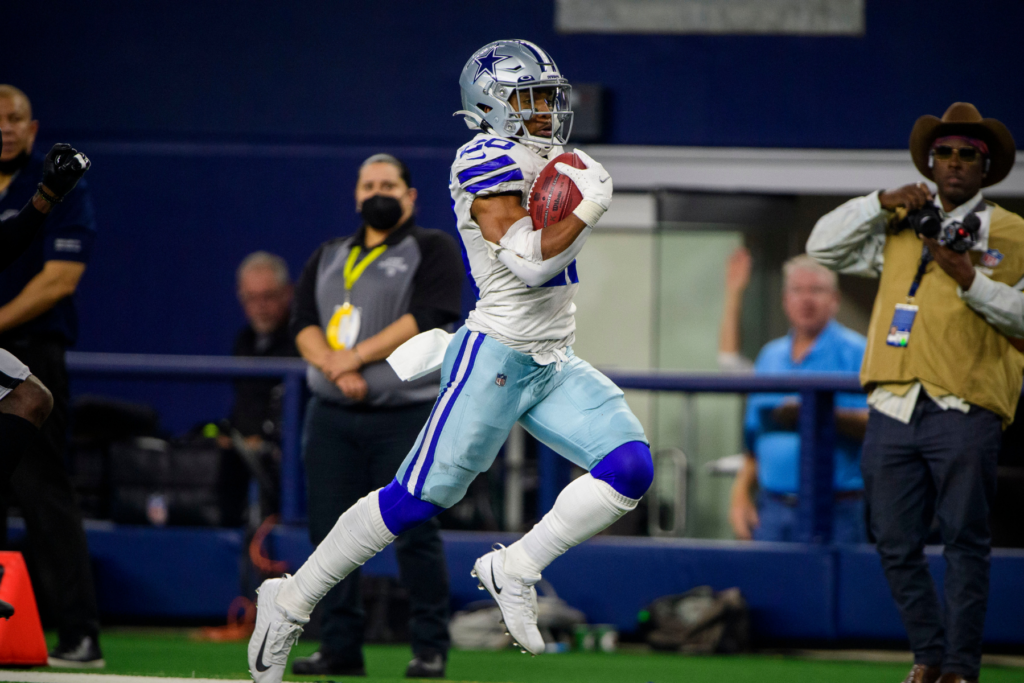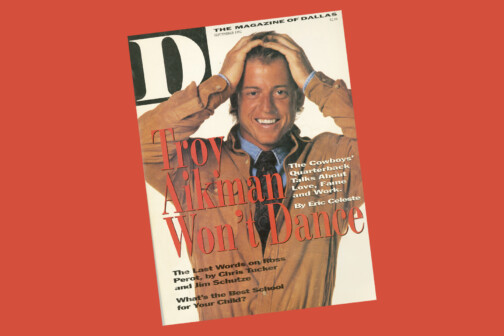A little more than six months have passed since the Dallas Cowboys called in sick to work the day of their Wild Card-round matchup with the San Francisco 49ers. They were the less physical team by a huge margin, and they were ill-prepared, out-coached, out-everythinged. But the reason that game still drives me crazy is mostly absent from the stories written in the aftermath of the game.
That loss has stuck with me because I have a seat on the board of the Tony Pollard Fan Club. With the Dallas offense stuck in quicksand, Pollard had just six offensive touches. Any assumption from the regular season—when Pollard had 115 fewer touches than Ezekiel Elliott despite being far more efficient—that Kellen Moore was strategically saving a heavy dose of Pollard for a game of massive import proved to be folly. This was just more of the same.
With Pollard entering the final year of his rookie contract, we are about to find out what, if anything, the Cowboys coaching staff learned from that game. This is an offense that, even when humming, lacks juice. Outside of CeeDee Lamb, Pollard is the one player capable of changing a game on a dime. His mere presence on the field and the myriad spots in which he’s comfortable lining up make the club more dynamic. I’m not saying he’s Deebo Samuel with the ball in his hands (the 49ers’ receiver/running back is also a tremendous blocker). What I am saying is we’ve never been allowed to find out how far apart the two really are.
Before we dig into the ample amount of data that prove Pollard’s effectiveness relative not just to Elliott but to the league at large, a word on the future of the Cowboys’ backfield: even in his limited usage, Pollard has vastly outperformed the expectations that come with being selected with pick 128 in 2019. A few months after nailing that pick, the front office decided to cave to Elliott’s holdout two years before he would’ve been a free agent. Part of me wonders whether they would have been so amenable to Elliott’s demands had Pollard been picked one year earlier. A larger part of me understands the likelihood that Zeke was always going to get that deal.
How do I know that? Because Pollard has increasingly outperformed Elliott since the day that contract was signed, yet Elliott still dominates the workload. It is peak Cowboys to have a dynamic, young player on a cheap contract parked on the sideline so that a player in decline on a terrible contract can stay on the field. Now, there is a real possibility neither player will be on the team past the upcoming season, when Pollard will be free and Elliott’s contract becomes more palatable to move on from. My bet right now is that Pollard finds greener pastures both financially and professionally, while the Cowboys work something out with Elliott that keeps him with the team for another couple of seasons.
It’s unclear whether a big year from Pollard would change Dallas’ thinking. What is clear, though, is a significantly increased role for Pollard gives the Cowboys the best chance to win games. Pollard’s usage this year should be treated as a referendum on the offensive staff. If they can’t figure out how to keep him on the field and get the ball in his hands, they should be relieved of their duties. Plain and simple.
You may have heard Pollard’s Pro Football Focus grade referenced throughout last season. Per PFF, he finished the season with the fourth-highest offensive grade among 60 qualified running backs. The grading at PFF has come a long way over the years, and while it’s not perfect by any means, I generally find that they match up with what most of us see when we watch the games. However, their advanced metrics are where we can really dig into why a player is grading so highly. I’ll give you the spoiler right up front: there is not a single rate-based metric where Elliott outperforms Pollard.
If we consider yards after contact per attempt, Pollard ranks fourth and Elliott 40th (again, out of 60). This is a stat that attempts to isolate running back play from the performance of the offensive line. Same story with missed forced tackles per attempt, where Pollard ranks 13th while Elliott checks in at 54th.
The goal of the offense is to move the chains and score points. Twenty-five percent of Pollard’s carries result in first downs or touchdowns, good for 11th-best in the NFL. Elliott’s mark ranks 43rd.
There are three common refrains I’ve heard in defense of Pollard’s limited usage. The first is very easy to disprove: while Pollard is explosive, the plays when he doesn’t break something off too often result in negative yardage. Well, Pollard had the fifth-fewest percent of his rushing attempts result in no gain or a loss of yards. (Elliott did rank a respectable 21st in this category last season.)
The second explanation I hear is Pollard is ineffective in pass protection. Fine, play them together! As my colleague Bob Sturm points out, they used two-running-back sets lightly to start last season, then went completely away from it:
They started the season with Pollard and Elliott on the field quite a bit: 19 times in the first three weeks and it had success. The Cowboys stopped doing it a lot around Week 4. They only used 20/21 together another 13 times in the next 10 weeks. They brought it back briefly for the Kansas City/Las Vegas stretch around Thanksgiving (probably because Cooper was out) and then pretty much used it only to kneel down for the rest of the year. That’s right, Thanksgiving Day was the last time we saw an actual play with Elliott and Pollard on the field.
Just like with the litany of rushing statistics, Pollard outperforms Elliott in every single receiving metric, too. Pollard split time in the slot in college, and he’s obviously comfortable there. He lined up as a slot receiver on 12 percent of his snaps last season, which was actually 14th-most in the NFL of all running backs. But why not double it? Why not have Pollard lead the league in slot snaps for all running backs? It would keep him on the field (with Elliott), and it would present a whole host of challenges for the defense. We talk quite a bit about Pollard in the slot stretching the opposition horizontally with pre-snap motion, which is certainly true. But here’s a crazy idea: why not see if Pollard can get behind a defense deep? I concede he’s not going to go out there and consistently make contested catches. But he was not targeted beyond 20 yards last year a single time.
The final argument excuse I hear when ranting about this is something to the effect of “Pollard may be able to do that in a limited role, but his production also may fall off if that role were expanded.” Well, as the offense went south in the middle of last year, I would’ve liked to have found this out. I already know what the other running back is doing with his heavy workload; the bar Pollard would have to clear isn’t all that high.
I get it: Elliott was hurt for much of last year. As far as I’m concerned, that’s even more reason to have had Pollard on the field more often. Pollard did suffer a torn plantar fascia in Week 13 (on a 58-yard touchdown run), which forced him to miss a game. But he returned in Week 15 and rushed 12 times for 74 yards. While he was almost certainly still dealing with this injury in the playoff game, he looked fine returning kicks. And if the Cowboys had two running backs dealing with injuries against San Francisco, I know which one I would have preferred to have a larger role in the game. Elliott played 48 snaps that day; Pollard, 31. Elliott had 16 touches; Pollard, six. And Dallas went into the offseason wondering what had just hit them.
Pollard played 35 percent of the Cowboys offensive snaps last season. That number has to be closer to or above 50 percent this year. An extra 10 to 12 snaps per game might not seem like a ton, but that’s 10 to 12 more chances for explosive plays—or at a minimum, the threat of them.
If the coaching staff elects to use Pollard and Elliott in the same manner this year, they will get the same results. And if they get the same results, they could be looking for employment elsewhere. Remind me what those Super Bowl odds are again?
Author







